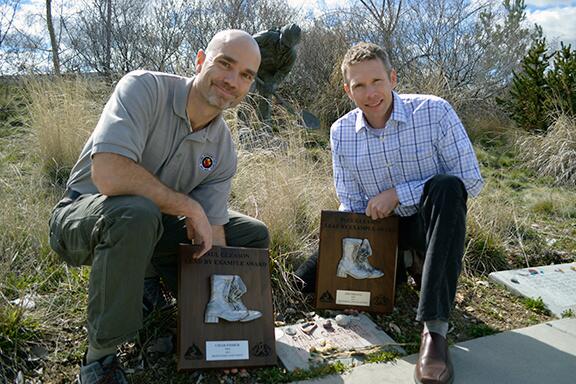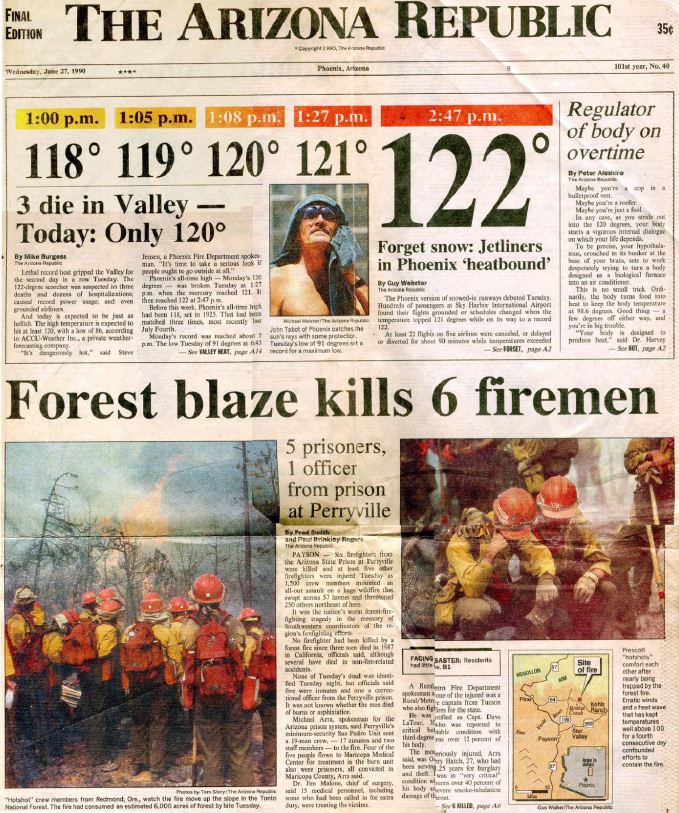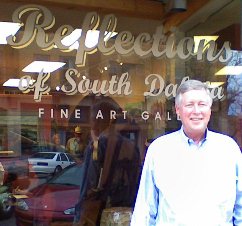
From the NPS Morning Report:
****
“Two staff members from the National Park Service Branch of Wildland Fire were recently awarded the prestigious Paul Gleason Lead by Example Award for 2013. The intent of this award is to recognize individuals or groups who exhibit Gleason’s professional spirit and who exemplify the wildland fire leadership values of duty, respect, and integrity.
Chad Fisher, wildland fire safety program manager, and Jim Shultz, wildland fire training program manager, each received the award. Only three individuals and one group from across the wildland fire service were chosen to receive this national award for 2013.
“To have not just one, but two employees, honored with this interagency award, really highlights the caliber of work and leadership by NPS wildland fire management staff,” said acting National Park Service Wildland Fire Branch Chief Mark Koontz. “Chad and Jim are outstanding representatives in their respective fields.”
 In addition to his mission, vision, and dedication to ensuring that firefighter safety is always the number one objective on all assignments and every fire, regardless of size or complexity, Chad Fisher was recognized for his work with the Dutch Creek mitigations. Chad’s actions to reach across agency boundaries have contributed to a shift in culture regarding incident-within-an-incident planning. His dedicated effort to ensure that staff understand, weigh, and communicate the consequences of placing firefighters in harm’s way to decision-makers, along with ensuring that there is a mechanism to evacuate injured firefighters, sets the example for all to follow.
In addition to his mission, vision, and dedication to ensuring that firefighter safety is always the number one objective on all assignments and every fire, regardless of size or complexity, Chad Fisher was recognized for his work with the Dutch Creek mitigations. Chad’s actions to reach across agency boundaries have contributed to a shift in culture regarding incident-within-an-incident planning. His dedicated effort to ensure that staff understand, weigh, and communicate the consequences of placing firefighters in harm’s way to decision-makers, along with ensuring that there is a mechanism to evacuate injured firefighters, sets the example for all to follow.
He was also commended for his work with firefighter nutrition, the Incident Response Pocket Guide revision, leadership development activities, facilitated learning analyses, and serious accident investigation teams. Chad’s leadership exemplifies the values of duty, respect, and integrity.
Jim Shultz was recognized for his ability to develop subordinates across agency boundaries through programs like the Fire and Aviation Mentoring program and the National Interagency Joint Apprentice Committee. As memorial group supervisor for the Honor Guards and Pipes and Drums, Jim’s calm demeanor and leadership skills helped ensure all honor guards worked together to make the Granite Mountain Hotshot Memorial Serviceas seamless as possible.
As an advocate for leadership development, Jim seeks improvement and develops others for the betterment of the individual as well as the team and organization. This has been shown through field assignments and pioneering the wildland fire leadership and career development video series to help young firefighters answer questions regarding the rights steps to take toward a permanent career as a wildland firefighter. Jim exemplifies the values of duty, respect and integrity.
The award was created by the NWCG Leadership Subcommittee to remember Paul Gleason’s contributions to the wildland fire service. During a career spanning five decades, Paul was a dedicated student of fire, a teacher of fire, and a leader of firefighters. The intent of this award is to recognize individuals or groups who exhibit this same spirit and who exemplify the wildland fire leadership values of duty, respect and integrity.
Congratulations to Chad and Jim on their achievements.”
****
Last year the awards were presented to Anthony Escobar, John Lauer and Shane Olpin.





